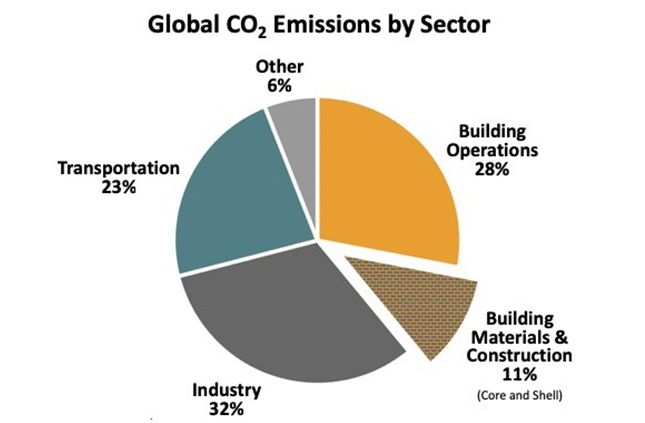By Brittany Porter
Senior Associate Brittany Porter is passionate about low-carbon architecture that promotes health and well-being for all. With experience in urban infill multifamily and commercial projects, Brittany strives to weave the technical elements of a building into the design concept, holistically integrating performance and aesthetics. She was the project architect and construction administrator of Northlake Commons, a life science lab-ready, mass timber, LEED Platinum workplace on the shores of Lake Union.
The content for this article was originally featured in the AIA Young Architect Forum Connection magazine in April 2021.
As an architect, you have probably been made aware of the urgency of climate action, but perhaps its connection to the practice of architecture is less clear. I want to express the significant value you as an architect can bring to climate action advocacy and where to start your journey.
As greenhouse gases, notably carbon dioxide, methane, nitrous oxide, and chlorofluorocarbons, are emitted into our atmosphere by our transportation systems, industrial and manufacturing facilities, agriculture practices, and buildings, they are destabilizing our climate and causing natural disasters such as the West Coast forest fires of last summer and possibly the February snowstorms in Texas. Scientists at the Intergovernmental Panel on Climate Change (IPCC) have tied climate change to a key figure: temperature rise in degrees Celsius compared with pre-industrial levels from 1850 to 1900. Because of greenhouse gases previously emitted and currently being emitted, we are expected to reach a 1.5°C temperature rise between 2030 and 2050. Today, we are at a rise of 0.5°C, and it has been determined that a global temperature rise of 1.5°C temperature is inevitable. This 1.5°C temperature rise will put our natural and human systems at risk of even further instability and collapse, but not nearly as much as if we were to reach a rise of 2°C. (1) This is why it is imperative to advocate for all sectors of industry and regulation to take climate action seriously so that we do not exceed 1.5°C.
While the above statistics sound daunting, my hope in writing this is to inspire you. The Architecture 2030 Challenge states that buildings generate nearly 40 percent of annual global greenhouse gas emissions. (2) These emissions come from a building’s operational carbon and its embodied carbon. Operational carbon represents the energy consumed to power and operate a building; embodied carbon represents the energy needed to produce the building’s construction materials. This means architects and the profession of architecture have an important place in the climate action advocacy effort. Through our holistic thinking and innovative problem-solving, we can drastically reduce one of the largest pieces of the emissions pie. In this article, I will share resources and organizations you may seek out to further establish yourself as a climate action advocate within your projects, firms, communities, and the global environment.
Increase Your Climate Vocabulary and Awareness
The IPCC is the United Nations body for assessing the science related to climate change. It has published a significant number of reports and graphics on climate change, and they are all free for download. Each report often begins with a summary that lays out its findings in accessible language. The 2014 Mitigation of Climate Change Report has a chapter dedicated to findings on buildings, including trends and drivers of their energy consumption. (3)
Join a Community to Learn From and With
I have found my best advocacy efforts have come from collaborating with and learning from others. There are many wonderful sustainability-oriented organizations to choose from, but one I have found particularly valuable is the Carbon Leadership Forum. The mission of the CLF is to decarbonize the built environment. It produces reports, shares resources, and produces climate action policy tools. It is primarily an online community, but there are hubs in cities all over the country and probably near you. (4)
Many local AIA components have a Committee on the Environment (COTE), which can be an excellent way to get involved in climate action programming in your city and become better connected with other architects passionate about climate action.
Get to Know the AIA Framework for Design Excellence
The National AIA COTE has curated several sustainability resources (5), including the Framework for Design Excellence. This framework “seeks to inform progress toward a zero- carbon, equitable, resilient, and healthy built environment.” (6)
My firm compares its projects against the framework to find the natural sustainability synergies already built into the design and where there is room to dive deeper. I recommend spending time with it and seeing how it might enhance your projects and be an asset to your firm.

Global Alliance for Buildings and Construction. 2018 GLOBAL STATUS REPORT
Seek Out Opportunities to Influence Local Building Codes
There are several ways to become involved in your jurisdiction’s code and policy writing. There are code committees and often code change cycles, and there are calls for feedback from architects and engineers. Opportunities will of course vary depending on your location, but I have found that once you express interest and join relevant mailing lists, the chances for involvement are numerous, and you do not need to be an expert to be helpful.
Connect With Your Legislators
Many AIA components facilitate efforts to lobby your state legislators about proposed bills that are in alignment with the AIA’s mission and values, which include climate action. (7) In my experience, my AIA component provided highlights of the bills we were focusing on and talking points for me to use in conversation with my representatives. Lobbying is much simpler than it seems from the outside. It is more about building connections and demonstrating that architects can be a knowledgeable and supportive professional group on climate issues.
Don’t Forget About the Intersectionality of Environmental Justice
Climate change is a humanitarian crisis as well as an environmental one. The EPA defines environmental justice as the fair treatment and meaningful involvement of all people regardless of race, color, national origin, or income concerning the development, implementation, and enforcement of environmental laws, regulations, and policies. This is paramount to remember when advocating for climate action. The best solutions will serve all members of society equally.
